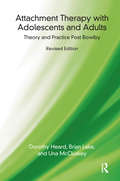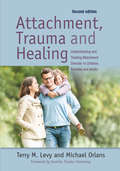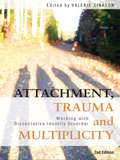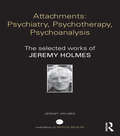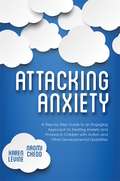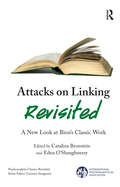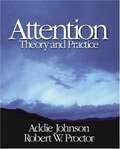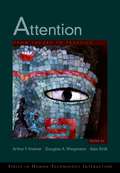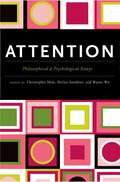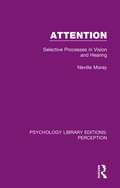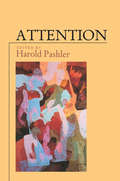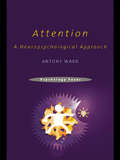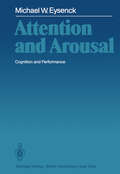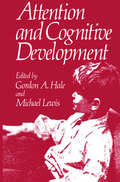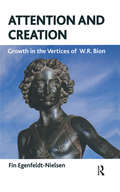- Table View
- List View
Attachment Therapy with Adolescents and Adults: Theory and Practice Post Bowlby
by Dorothy Heard Una McCluskey Brian LakeThis is a revised edition of an important title originally published in 2009. It is written primarily for psychotherapists and other practitioners and describes a new and effective form of dynamic therapy designed for working with adults and with adolescents. The theory, on which the new form of therapy is based, is centred in a paradigm that extends and crucially alters the paradigm for developmental psychology opened by the Bowlby/Ainsworth attachment theory. It describes a pre-programmed process, the dynamics sustaining attachment and interest sharing, which is activated as soon as people perceive that they are in danger. This process is made up of seven pre-programmed systems which interact with one another as an integrated whole. They include Bowlby's two complementary goal-corrected behavioural systems: attachment (also referred to as careseeking) and caregiving. Whenever the process is able to function effectively, it enables people to adapt more constructively and co-operatively to changing circumstances.
Attachment Therapy with Adolescents and Adults: Theory and Practice Post Bowlby
by Dorothy Heard Una McCluskey Brian LakeThis is a revised edition of an important title originally published in 2009. It is written primarily for psychotherapists and other practitioners and describes a new and effective form of dynamic therapy designed for working with adults and with adolescents. The theory, on which the new form of therapy is based, is centred in a paradigm that extends and crucially alters the paradigm for developmental psychology opened by the Bowlby/Ainsworth attachment theory. It describes a pre-programmed process, the dynamics sustaining attachment and interest sharing, which is activated as soon as people perceive that they are in danger. This process is made up of seven pre-programmed systems which interact with one another as an integrated whole. They include Bowlby's two complementary goal-corrected behavioural systems: attachment (also referred to as careseeking) and caregiving. Whenever the process is able to function effectively, it enables people to adapt more constructively and co-operatively to changing circumstances.
Attachment, Trauma, and Healing: Understanding and Treating Attachment Disorder in Children, Families and Adults
by Sumiko Hennessy Terry M. Levy Michael OrlansNow in a fully updated and expanded edition, Levy and Orlans' classic text provides a comprehensive overview of attachment theory, how attachment issues manifest, and how they can be treated. The book covers attachment-focused assessment and diagnosis, specialised training and education for caregivers, treatment for children and caregivers and early intervention and prevention programmes for high-risk families. The authors explain their unique models of 'corrective attachment therapy' and 'corrective attachment parenting', and provide practical guidance on goals and techniques for clinicians who work with maltreated and attachment disordered children and families. This second edition incorporates advances in the fields of child and family psychology that have occurred since the book first published in 1998, with substantial new sections on interpersonal neurobiology, adult and couple treatment, the application of positive psychology. Clear, authoritative and skills-oriented, this is the essential guide to attachment for psychologists, social workers, clinicians, as well as foster and adoptive parents.
Attachment, Trauma, and Healing: Understanding and Treating Attachment Disorder in Children, Families and Adults (PDF)
by Michael Orlans Sumiko Hennessy Terry M. LevyNow in a fully updated and expanded edition, Levy and Orlans' classic text provides a comprehensive overview of attachment theory, how attachment issues manifest, and how they can be treated. The book covers attachment-focused assessment and diagnosis, specialised training and education for caregivers, treatment for children and caregivers and early intervention and prevention programmes for high-risk families. The authors explain their unique models of 'corrective attachment therapy' and 'corrective attachment parenting', and provide practical guidance on goals and techniques for clinicians who work with maltreated and attachment disordered children and families. This second edition incorporates advances in the fields of child and family psychology that have occurred since the book first published in 1998, with substantial new sections on interpersonal neurobiology, adult and couple treatment, the application of positive psychology. Clear, authoritative and skills-oriented, this is the essential guide to attachment for psychologists, social workers, clinicians, as well as foster and adoptive parents.
Attachment, Trauma and Multiplicity: Working with Dissociative Identity Disorder
by Valerie SinasonThis Revised Edition of Attachment, Trauma and Multiplicity investigates the subject of Dissociative Identity Disorder. With brand new chapters on police work and attachment theory it has been fully updated to include new research and the latest understanding of patterns of attachment theory that lead to dissociation. With contributions from psychotherapists, psychiatrists, psychoanalysts and service users this book covers the background history and a description of the condition along with the issues of diagnoses and treatment. It also looks at: the phenomenon of DID the conflicting models of the human mind that have been found to try and understand DID the political conflict over the subject including problems for the police clinical accounts and personal writing of people with DID. Attachment, Trauma and Multiplicity, Second Edition will prove essential reading for therapists and mental health workers as well as being a valuable resource for graduates and researchers.
Attachment, Trauma and Multiplicity: Working with Dissociative Identity Disorder
by Valerie SinasonThis Revised Edition of Attachment, Trauma and Multiplicity investigates the subject of Dissociative Identity Disorder. With brand new chapters on police work and attachment theory it has been fully updated to include new research and the latest understanding of patterns of attachment theory that lead to dissociation. With contributions from psychotherapists, psychiatrists, psychoanalysts and service users this book covers the background history and a description of the condition along with the issues of diagnoses and treatment. It also looks at: the phenomenon of DID the conflicting models of the human mind that have been found to try and understand DID the political conflict over the subject including problems for the police clinical accounts and personal writing of people with DID. Attachment, Trauma and Multiplicity, Second Edition will prove essential reading for therapists and mental health workers as well as being a valuable resource for graduates and researchers.
Attachments: The selected works of Jeremy Holmes (World Library of Mental Health)
by Jeremy HolmesFor three decades Jeremy Holmes has been a leading figure in psychodynamic psychiatry in the UK and across the world. He has played a central role in promoting the ideas of John Bowlby and in developing the clinical applications – psychiatric and psychotherapeutic – of Attachment Theory in working with adults. Drawing on both psychoanalytic and attachment ideas, Holmes has been able to encompass a truly biopsychosocial perspective. As a psychotherapist Holmes brings together psychodynamic, systemic and cognitive models, alert to vital differences, but also keenly sensitive to overlaps and parallels. This volume of selected papers brings together the astonishing range of Holmes' interests and contributions. The various sections in the book cover: An extended interview – covering Holmes’ career and philosophy as a psychodynamic psychiatrist 'Juvenilia' – sibling relationships, the psychology of nuclear weapons, and the psychodynamics of surgical intervention. Psychodynamic psychiatry: Integrative and Attachment-Informed A psychotherapy section in which he develops his model of psychotherapeutic change 'Heroes' – biographical pieces about the major influences including, John Bowlby, Michael Balint, David Malan, Jonathan Pedder and Charles Rycroft. 'Ephemera' – brief pieces covering such topics as frequency of psychodynamic sessions and fees. Attachments: Psychiatry, Psychotherapy, Psychoanalysis - The Selected Works of Jeremy Holmes will be essential and illuminating reading for practitioners and students of psychiatry and psychotherapy in all its guises.
Attachments: The selected works of Jeremy Holmes (World Library of Mental Health)
by Jeremy HolmesFor three decades Jeremy Holmes has been a leading figure in psychodynamic psychiatry in the UK and across the world. He has played a central role in promoting the ideas of John Bowlby and in developing the clinical applications – psychiatric and psychotherapeutic – of Attachment Theory in working with adults. Drawing on both psychoanalytic and attachment ideas, Holmes has been able to encompass a truly biopsychosocial perspective. As a psychotherapist Holmes brings together psychodynamic, systemic and cognitive models, alert to vital differences, but also keenly sensitive to overlaps and parallels. This volume of selected papers brings together the astonishing range of Holmes' interests and contributions. The various sections in the book cover: An extended interview – covering Holmes’ career and philosophy as a psychodynamic psychiatrist 'Juvenilia' – sibling relationships, the psychology of nuclear weapons, and the psychodynamics of surgical intervention. Psychodynamic psychiatry: Integrative and Attachment-Informed A psychotherapy section in which he develops his model of psychotherapeutic change 'Heroes' – biographical pieces about the major influences including, John Bowlby, Michael Balint, David Malan, Jonathan Pedder and Charles Rycroft. 'Ephemera' – brief pieces covering such topics as frequency of psychodynamic sessions and fees. Attachments: Psychiatry, Psychotherapy, Psychoanalysis - The Selected Works of Jeremy Holmes will be essential and illuminating reading for practitioners and students of psychiatry and psychotherapy in all its guises.
Attacking Anxiety: A Step-by-Step Guide to an Engaging Approach to Treating Anxiety and Phobias in Children with Autism and Other Developmental Disabilities
by Karen Levine Naomi CheddDrawing on the principles of Cognitive Behavioral Therapy (CBT), this book sets out a clear, enjoyable, step-by-step approach for addressing the sorts of anxieties, fears and phobias that are so common in children and teens with Autism Spectrum Disorders (ASD) and related challenges. Using this easy-to-follow model, parents and professionals will have the tools they need to help children and teens cope with and sometimes overcome anxieties caused by everyday occurrences. The book covers seven common scenarios, from fears of environmental sounds and visiting the doctor or dentist, to anxieties around transitions, changes to schedules and an intolerance for making mistakes. The model can be adapted to suit almost any anxiety or phobia and is ideal for use at home, at school and in clinical settings where it can be integrated into a variety of treatment approaches and styles. Designed to help parents of children with autism spectrum disorders and the teachers and therapists who work with them, this book is an excellent resource for successfully alleviating many of the anxieties and phobias that interfere with life enjoyment, not only for the child but for the entire family.
Attacking Anxiety: A Step-by-Step Guide to an Engaging Approach to Treating Anxiety and Phobias in Children with Autism and Other Developmental Disabilities (PDF)
by Karen Levine Naomi CheddDrawing on the principles of Cognitive Behavioral Therapy (CBT), this book sets out a clear, enjoyable, step-by-step approach for addressing the sorts of anxieties, fears and phobias that are so common in children and teens with Autism Spectrum Disorders (ASD) and related challenges. Using this easy-to-follow model, parents and professionals will have the tools they need to help children and teens cope with and sometimes overcome anxieties caused by everyday occurrences. The book covers seven common scenarios, from fears of environmental sounds and visiting the doctor or dentist, to anxieties around transitions, changes to schedules and an intolerance for making mistakes. The model can be adapted to suit almost any anxiety or phobia and is ideal for use at home, at school and in clinical settings where it can be integrated into a variety of treatment approaches and styles. Designed to help parents of children with autism spectrum disorders and the teachers and therapists who work with them, this book is an excellent resource for successfully alleviating many of the anxieties and phobias that interfere with life enjoyment, not only for the child but for the entire family.
Attacks on Linking Revisited: A New Look at Bion's Classic Work (The International Psychoanalytical Association Psychoanalytic Classics Revisited)
by Catalina BronsteinThis book aims at providing further contributions inspired by Bion's paper Attacks on Linking (1959) by a distinguinshed group of scholars who have focused on different aspects of his propositions.Contributors: Christine Anzieu-Premmereur, Rachel B. Blass, Ronald Britton, Catalina Bronstein, Elias Mallet da Rocha Barros, Elizabeth Lima da Rocha Barros, Antonino Ferro, Jay Greenberg, Monica Horovitz, Clara Nemas, Edna O'Shaughnessy, Rudi Vermote
Attacks on Linking Revisited: A New Look at Bion's Classic Work (The International Psychoanalytical Association Psychoanalytic Classics Revisited)
by Catalina BronsteinThis book aims at providing further contributions inspired by Bion's paper Attacks on Linking (1959) by a distinguinshed group of scholars who have focused on different aspects of his propositions.Contributors: Christine Anzieu-Premmereur, Rachel B. Blass, Ronald Britton, Catalina Bronstein, Elias Mallet da Rocha Barros, Elizabeth Lima da Rocha Barros, Antonino Ferro, Jay Greenberg, Monica Horovitz, Clara Nemas, Edna O'Shaughnessy, Rudi Vermote
Attention: Theory and Practice (PDF)
by Addie Johnson Robert ProctorAttention is one of the fastest growing research areas in cognitive psychology. In light of the growing importance of this topic, there are surprisingly few texts that provide a coherent overview of the field of attention. Authors Addie Johnson and Robert W. Proctor have written Attention: Theory and Practice for students, researchers, and practitioners who wish to gain insight into this area in a comprehensible and consistent manner. Attention: Theory and Practice provides a balance between a readable overview of attention and an emphasis on how theories and paradigms for the study of attention have developed. The book highlights the important issues and major findings while giving sufficient details of experimental studies, models, and theories so that results and conclusions are easy to follow and evaluate.
Attention: From Theory to Practice (Human Technology Interaction Series)
by Arthur F. Kramer Douglas A. Wiegmann Alex KirlikThe study of attention in the laboratory has been crucial to understanding the mechanisms that support several different facets of attentional processing: Our ability to both divide attention among multiple tasks and stimuli, and selectively focus it on task-relevant information, while ignoring distracting task-irrelevant information, as well as how top-down and bottom-up factors influence the way that attention is directed within and across modalities. Equally important, however, is research that has attempted to scale up to the real world this empirical work on attention that has traditionally been well controlled by limited laboratory paradigms and phenomena. These types of basic and theoretically guided applied research on attention have benefited immeasurably from the work of Christopher Wickens. This book honors Wickens' many important contributions to the study of attention by bringing together researchers who examine real-world attentional problems and questions in light of attentional theory. The research fostered by Wickens' contributions will enrich not only our understanding of human performance in complex real-world systems, but also reveal the gaps on our knowledge of basic attentional processes.
Attention: Philosophical and Psychological Essays
by Christopher Mole Declan Smithies Wayne WuAttention has been studied in cognitive psychology for more than half a century, but until recently it was largely neglected in philosophy. Now, however, attention has been recognized by philosophers of mind as having an important role to play in our theories of consciousness and of cognition. At the same time, several recent developments in psychology have led psychologists to foundational questions about the nature of attention and its implementation in the brain. As a result there has been a convergence of interest in fundamental questions about attention. This volume presents the latest thinking from the philosophers and psychologists who are working at the interface between these two disciplines. Its fourteen chapters contain detailed philosophical and scientific arguments about the nature and mechanisms of attention; the relationship between attention and consciousness; the role of attention in explaining reference, rational thought, and the control of action; the fundamental metaphysical status of attention, and the details of its implementation in the brain. These contributions combine ideas from phenomenology, neuroscience, cognitive psychology, and philosophy of mind to further our understanding of this centrally important mental phenomenon, and to bring to light the foundational questions that any satisfactory theory of attention will need to address.
Attention: Selective Processes in Vision and Hearing (Psychology Library Editions: Perception #23)
by Neville MorayThe early years of modern experimental psychology were marked by a considerable amount of research on attention, and much work was carried out in the laboratories of Wundt, Titchener and Helmholtz. For various reasons, research on attention declined from 1920 until the 1950s. Under the early philosophy of behaviourism, attention became suspect as a ‘mentalistic’ concept. At the time of original publication in 1969, however, much work had been done to quantify and make objective research in this area. This was of increasing importance in a world dominated by communication networks, and ‘man-machine’ systems, in which the human element is the weakest link due to the limits on the rate at which man can handle information. Following the publication of Broadbent’s Perception and Communication in 1958, work on attention had begun to pour from an ever increasing number of laboratories. This book is dedicated to summarising what we knew, and attempts to survey the behavioural research in vision and hearing which throw light on how we share and direct attention, what are the limits of attention, to make some general methodological recommendations, to review current theories of the time, and to provide a guide to the relevant physiological work. As far as possible, work on memory has been omitted. A bibliography of the major work to the spring of 1969 is included.
Attention: Selective Processes in Vision and Hearing (Psychology Library Editions: Perception #23)
by Neville MorayThe early years of modern experimental psychology were marked by a considerable amount of research on attention, and much work was carried out in the laboratories of Wundt, Titchener and Helmholtz. For various reasons, research on attention declined from 1920 until the 1950s. Under the early philosophy of behaviourism, attention became suspect as a ‘mentalistic’ concept. At the time of original publication in 1969, however, much work had been done to quantify and make objective research in this area. This was of increasing importance in a world dominated by communication networks, and ‘man-machine’ systems, in which the human element is the weakest link due to the limits on the rate at which man can handle information. Following the publication of Broadbent’s Perception and Communication in 1958, work on attention had begun to pour from an ever increasing number of laboratories. This book is dedicated to summarising what we knew, and attempts to survey the behavioural research in vision and hearing which throw light on how we share and direct attention, what are the limits of attention, to make some general methodological recommendations, to review current theories of the time, and to provide a guide to the relevant physiological work. As far as possible, work on memory has been omitted. A bibliography of the major work to the spring of 1969 is included.
Attention (Studies in Cognition)
by Harold PashlerThis collection of essays, intended as a text for students, examines the different facets of research into attention. The book is divided into two sections: one deals with psychological research into such areas as visual search, dual-task interference and attentional bottleneck; the other deals with approaches to neural-network modelling and the effects of brain damage on attention.
Attention (Studies in Cognition)
by Harold PashlerThis collection of essays, intended as a text for students, examines the different facets of research into attention. The book is divided into two sections: one deals with psychological research into such areas as visual search, dual-task interference and attentional bottleneck; the other deals with approaches to neural-network modelling and the effects of brain damage on attention.
Attention: A Neuropsychological Approach
by Antony WardAttention: A Neuropsychological Approach provides a fascinating overview of the neuropsychological aspects of attention, revealing how we select our information, divide our attention and control our focus of interest. Through fully integrating cognitive neuropsychological perspectives on attention, Anthony Ward demonstrates how each approach can illuminate the other. Examples are provided to show how the application of theories of attention can help to further our understanding of conditions such as dementia, schizophrenia, head injury and attention deficit hyperactivity disorder. This clear introduction will be of great interest to undergraduates studying neuropsychology, clinical psychology, occupational therapy and mental health nursing.
Attention: A Neuropsychological Approach
by Antony WardAttention: A Neuropsychological Approach provides a fascinating overview of the neuropsychological aspects of attention, revealing how we select our information, divide our attention and control our focus of interest. Through fully integrating cognitive neuropsychological perspectives on attention, Anthony Ward demonstrates how each approach can illuminate the other. Examples are provided to show how the application of theories of attention can help to further our understanding of conditions such as dementia, schizophrenia, head injury and attention deficit hyperactivity disorder. This clear introduction will be of great interest to undergraduates studying neuropsychology, clinical psychology, occupational therapy and mental health nursing.
Attention and Arousal: Cognition and Performance
by Michael EysenckThe thinker who has a mortal fear of being wrong will give all that is valuable in himself to that little ambition. Walter Lippmann (1914) Psychology has always been plagued by passing fads and fan cies to a greater extent than is seemly in a scientific discipline. Over the past few years the Zeitgeist can be summed up by the two words 'cognitive psychology'. Indeed, a recent poll of academic psychologists in American indicated that over 80% of them regarded themselves as cognitive psychologists! Cognitive psychology is in the ascendant, but it has never been clear to me that it has addressed all of the appropriate is sues. In particular, information processing in the real world (and even in the laboratory) occurs within a motivational and emotional context, but cognitive psychologists usually main tain the convenient fiction that cognition can fruitfully be stud ied in isolation. The main reason for writing this book was to at tempt to demonstrate that there can be a useful cross-fertiliza tion between cognitive and motivational-emotional psycholo gy and that there are already tantalizing glimpses of the poten tial advantages of such inter-disciplinary research. The ideas of Donald Broadbent and his associates have exer cised a formative influence during the writing of this book. They discovered some years ago that there are intriguing simi larities (as well as differences) in the effects on performance of such apparently quite disparate factors as white noise, time of day, introversion-extraversion and incentive.
Attention and Cognitive Development
by Gordon A. Hale and Michael Lewis"My experience is what I agree to attend to," wrote William James (1890) nearly a century ago in his Principles of Psychology. Although certainly not the first to recognize the importance of attention in man's experience--poets and philosophers throughout history have touched upon the concept in one way or another-James deserves credit for having accorded attention a central role in the systematic study of the mind. With the advancement of psychology since that time, except during the behaviorist digression, the concept of attention has been an integral part of many prominent theories dealing with learning, thinking, and other aspects of cognitive functioning. Indeed, attention is an important determinant of experience from birth throughout development. This has been an implicit assumption underlying our view of cognition since the writings of Charles Darwin (1897) and Wilhelm Preyer (1888) as well as James, all of whom offered provocative insights about the developing child's commerce with the environment. Al though systematic research on attention in children was slow to pick up during the early part of this century, interest in the developmental study of attention has expanded enormously in recent years.
Attention and Creation: Growth in the Vertices of W.R. Bion
by Fin Egenfeldt-NielsenThe implicit background of this book consists of an optimistic approach to creating mind forms that improve the condition of humanity, deriving from the legends of Christ and the Buddha and the experiences of mystics in both Eastern and Western cultures, as well as from psychoanalytic thought. This book is divided into four parts. The first is a brief introduction to Bion himself - it assumes a certain degree of familiarity with his life and work and includes only what is essential to understanding the work on which this book is centred. The second part is an explication of the main thesis, demonstrating how Bion articulates his theory and system of the transformation of the immaterial elements which constitute the psyche. The third part elucidates views on therapeutic techniques - the author's own and those of Bion. Touching on the routes available to those wishing to become therapists it also discusses the demands this may place on those in a position to help, be they teachers, supervisors or more experienced fellow therapists.
Attention and Creation: Growth in the Vertices of W.R. Bion
by Fin Egenfeldt-NielsenThe implicit background of this book consists of an optimistic approach to creating mind forms that improve the condition of humanity, deriving from the legends of Christ and the Buddha and the experiences of mystics in both Eastern and Western cultures, as well as from psychoanalytic thought. This book is divided into four parts. The first is a brief introduction to Bion himself - it assumes a certain degree of familiarity with his life and work and includes only what is essential to understanding the work on which this book is centred. The second part is an explication of the main thesis, demonstrating how Bion articulates his theory and system of the transformation of the immaterial elements which constitute the psyche. The third part elucidates views on therapeutic techniques - the author's own and those of Bion. Touching on the routes available to those wishing to become therapists it also discusses the demands this may place on those in a position to help, be they teachers, supervisors or more experienced fellow therapists.
